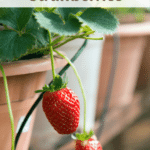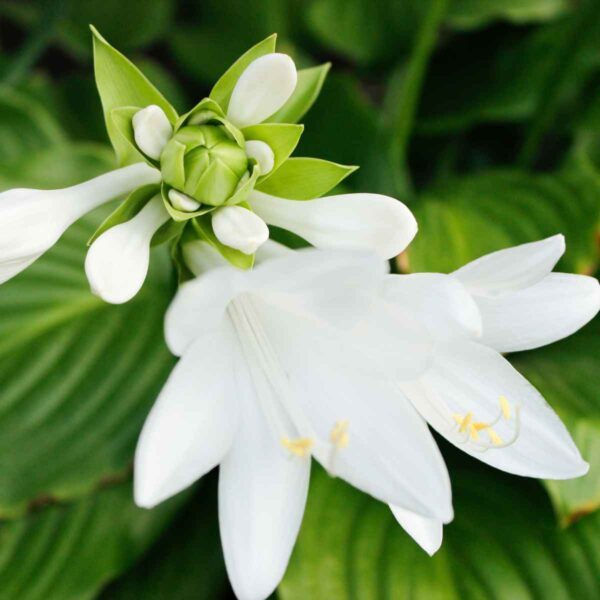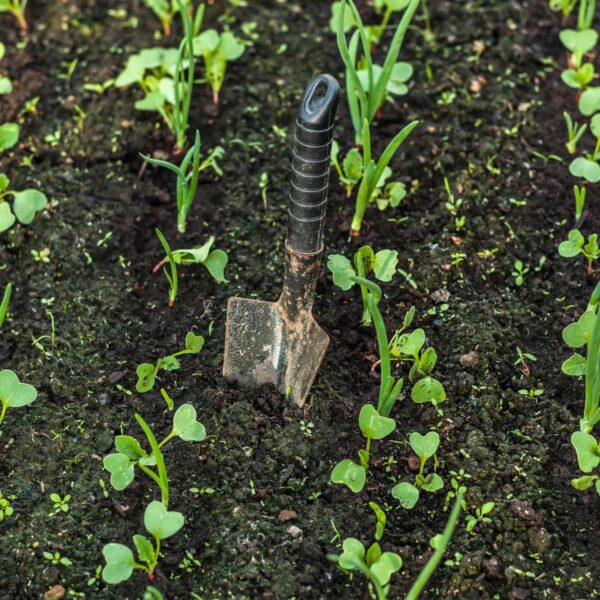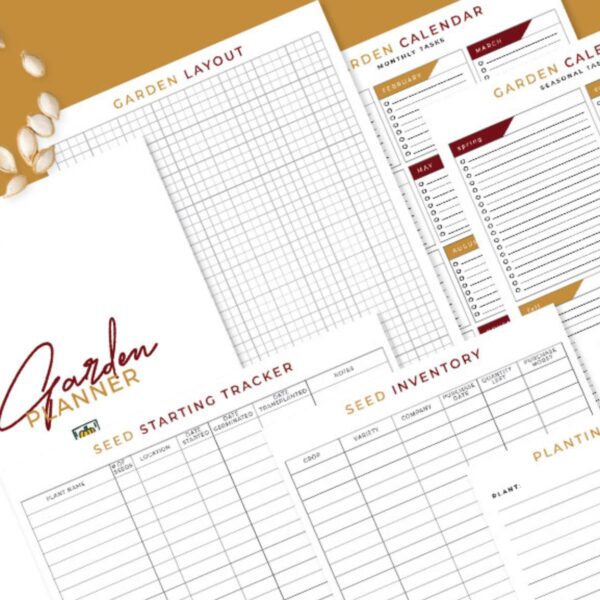What You Need to Know to Grow Yummy Big Strawberries
on Mar 10, 2023, Updated Oct 28, 2023
This post may contain affiliate links. Please read our disclosure policy.
If you’re wondering how to grow big strawberries, you need this information! Strawberries can be tricky for home gardeners but with these tips you’ll be able to enjoy big, juicy, sweet, fresh strawberries straight from your garden year after year.
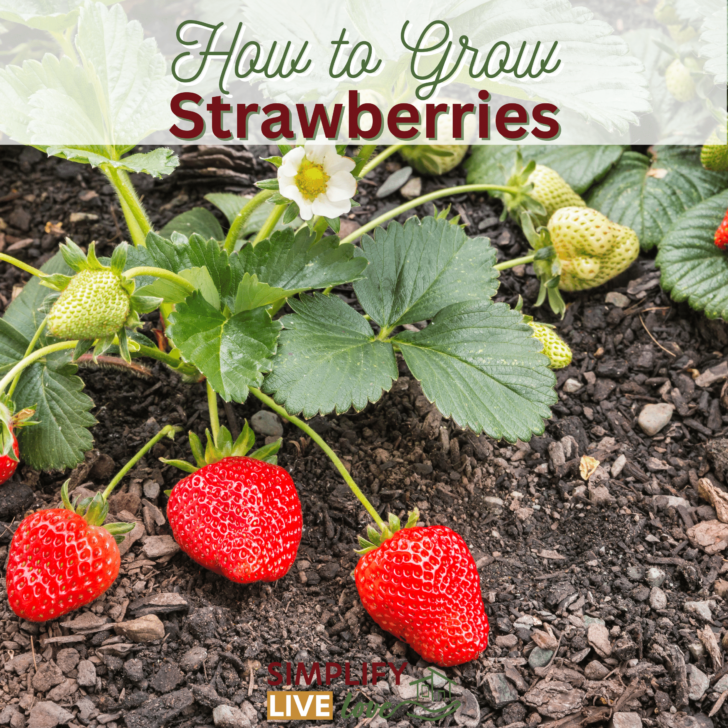
Growing your own strawberries is just the best! Fresh strawberries are so delicious with ice cream, as homemade strawberry syrup, or baked goods. Plus they’re cooling and bring a bit of summer to you in middle of winter.
Their flavor is unique, like nothing you can buy from a grocery store. My favorite way to enjoy them is sitting on the deck, with the sounds of the animals and the kids around. Homegrown strawberries are special and are worth any effort it takes to grow them!!
- Deciding Which Types of Strawberries to Grow
- How to Plant Strawberry Crowns
- How to Grow Strawberries From Seed
- How to Grow Strawberries in Pots and Containers
- Strawberry Problems: Pests and Diseases
- Best Companion Plants to Use & Which Ones to Avoid
- How Long Do Strawberries Take To Grow
- When to Harvest Strawberries
- How to Harvest Strawberries
- How to Preserve Strawberries to Last all Year
- Need More Gardening Tips?
Deciding Which Types of Strawberries to Grow
The first key to successfully growing strawberries is to pick the right type. There are three main types of strawberries: June-bearing, everbearing, and day-neutral. Understanding the difference will help you choose the best fit for your garden and needs.
June-Bearing Varieties
June-bearing strawberries grow and ripen all at once to produce a single large crop in late spring or early summer (depending on your growing zone). In on my garden zone, zone 5, June bearing plants are excellent if you want to harvest and preserve your fruit simultaneously and to have fresh berries for all your 4th of July desserts.
However, June-bearing strawberries do not produce well the first year. To get the best harvest in the second year, it’s a good idea to clip flower buds off until the end of July. This will encourage strong root growth and a larger harvest in year 2. Starting on August 1 of the first year, you can let the plants flower as they want.
While it’s hard to take off of those flowers that could become strawberries, it will pay back in prolific, healthy plants for in year two. You’ll be rewarded in year two with larger, sweeter berries. So as much as it may pain you, remove those blossoms in year 1.
June-bearing strawberries grow best when you have plenty of room to give them and use an organic fertilizer. You should choose to grow June-bearing plants:
- If you want larger berries
- If you want to harvest strawberries all at once
- You have the patience to let the strawberry bed become established by picking off flowers the first year
My favorite June-bearing strawberry varieties are Jewel and Earliglow.

Everbearing Strawberries
Everbearing strawberries produce two to three harvests per year, with the first one usually in late spring or early summer, followed by another in mid-summer and if you’re lucky, maybe even one in early fall. These are nice for an extended season of fresh eating and preserving.
Ever-bearing strawberries grow anywhere and require little effort or involvement from you. They are the easy-to-grow or beginner-friendly variety to grow. It is best to get them started in early spring.
My favorite type of ever-bearing varieties include Eversweet and Ozark Beauty.
Day-Neutral Strawberries
This third type of berry, day-neutral strawberries, grow the whole season and have a longer harvest in more manageable amounts. Day-neutral strawberries produce fruit continuously throughout the growing season once they start producing.
Be aware that they tend to produce smaller, but more numerous berries than June-bearing or everbearing varieties. If you want to harvest smaller strawberries throughout the growing season, day-neutral plants might be the variety for you.
Some people might not like day-neutral plants because they require daily effort for the entire growing season. But, they might be the perfect strawberry for families with little ones who like to graze the strawberry patch for treats throughout the summer.
Day neutral strawberries need to have the patch refreshed every year as they do not last long. They are more annual than perennial. They also do better if you have a shorter growing season or tend to have late hard frosts in spring.
My favorite day-neutral types are Alpine and Seascape.
When choosing the varieties of strawberries to grow in your garden, also consider growing conditions and weather. Certain varieties do better in certain zones, so check if your zone will grow specific types, as Alpine strawberries prefer cooler zones and will not do well in hot, muggy summers.
In general, June bearing strawberries tend to prefer cooler climates, while everbearing and day-neutral varieties are more adaptable to a range of temperatures.
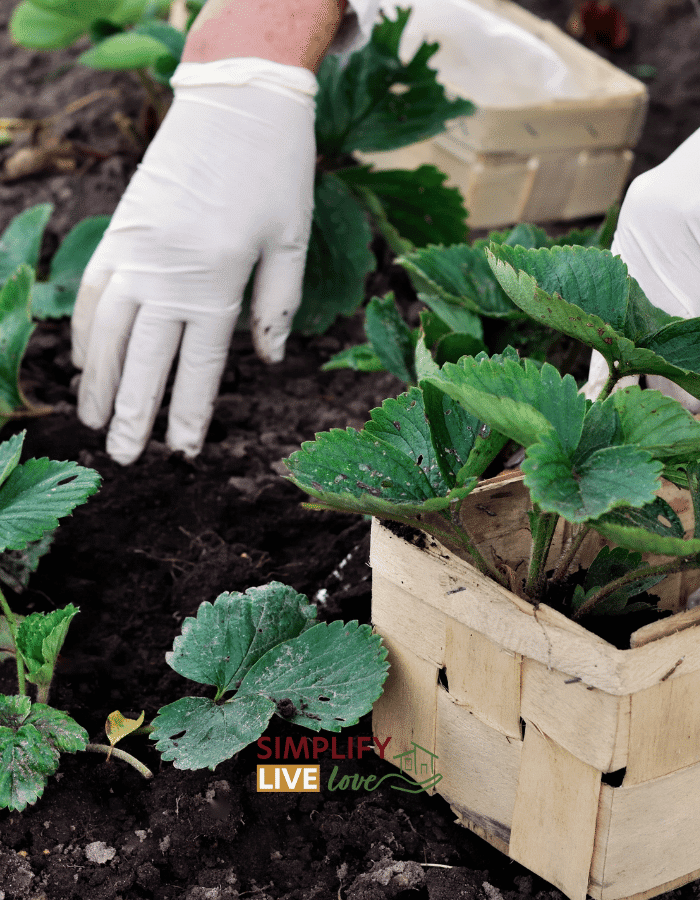
How to Plant Strawberry Crowns
Strawberries are usually grown from dormant bare-root clumps called crowns or from young plants. Planting crowns is more economical than planting established plants so that’s what we’ll focus on here. You can plant berries in garden beds, hill rows, containers, or a matted row system.
There are a there are a few key things that you should keep in mind when planting crowns. First, make sure to do a soil test first. Strawberries like a ph of 5.3-6.5, so make sure you amend your soil as needed to get to that ph level.
It’s also recommended that you soak the crowns in water or a diluted kelp/fish solution for several hours before planting to give them a good start to growing.
You may also want to plant crowns in weed fabric and strawberries do not like to compete with weeds for space and nutrients. Having a good weed control strategy in place is key to being able to have a large harvest of delicious berries.
To plant crowns, dig a hole that is six to eight inches deep and two times as wide as the length of the roots. Be sure to fan out the roots out and place the crown so that it sits just at soil level. If the roots are long, you can cut them back to around 4″.
Remember not to plant the crowns too deep, as they’ll rot if covered with soil. The wrong planting depth can also affect fruit production even if they don’t rot.
Also, aim to plant your bare root plants as soon as possible after purchase so that they don’t “wake up” before you get them in the ground.
All strawberries are heavy feeders, so planting the crowns with a lot of nitrogen by using bone meal, blood meal, or bat guano, will encourage root and leaf growth. Be sure to mix the bone meal and fertilizer into the bed.
Using the Square Foot Gardening Method
You can successfully grow strawberries using the square foot gardening method. You can plant 4 crowns per square foot, but you’ll need to make sure you keep the runners trimmed – so don’t allow them to grow. Strawberries have low roots, they require one inch of water per square foot per week. Planting strawberry plants along the perimeter of your bed will enable allows the plants to spill over the side.
You’ll also want to mulch heavily around your strawberries to keep weeds down and soil from splashing onto the leaves and fruit, which leads to fruit production loss from pests and fungal diseases. Straw mulch is best, but you can use other types of mulch as well. Read all about where to find free mulch to use in your garden in this post.
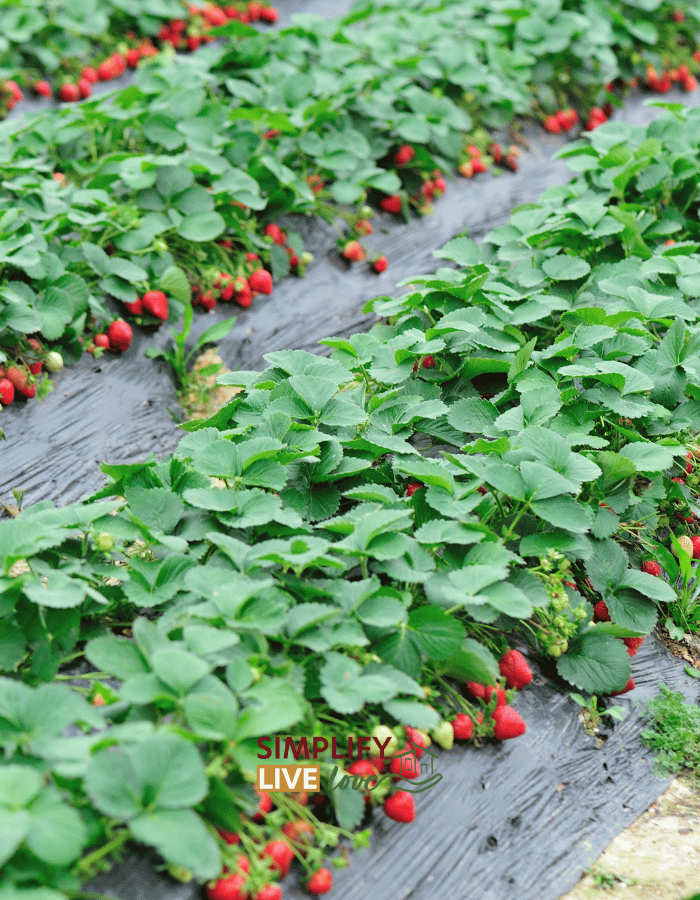
Growing Strawberries in Matted Rows
I like the matted row system for growing June-bearing strawberries best. The method products best results for people with a lot of garden space who want a big crop. It’s also great for gardeners who want to encourage strawberry runners to take advantage of the perennial nature of strawberries.
To use the matted row system, plant crowns 1½-2’ apart in rows with 3½-4’ between rows in a sunny location in early spring. The mother plant will put out runners to grow daughter plants. You’ll end up with 1 1/2 – 2′ wide rows of strawberry plants with a nice sized walking row down the middle.
How to Grow Strawberries From Seed
If you want to start strawberry seeds, here’s how. Strawberry seeds should be started in a seed tray, 10-12 weeks indoors before your last frost date. You must also stratify your strawberry seeds four months before your last frost day. It take 3 to 10 days for seeds to germinate, but using a germination mat will speed up the process by several days.
How to Stratify Strawberry Seeds
Strawberry seeds need to go through a cold cycle called stratifying in order to grow. To stratify your strawberry seeds, place them in the freezer in their seed envelope for a month. Be sure to set a reminder so you get them out of the freezer.
When to Plant Strawberries Outside
Plant strawberry plants outside three weeks before your last frost date. Instead of starting the seeds indoors, you can also use the winter sowing method. I prefer to start my strawberry seeds outside by winter sowing in quality potting soil. This gives me more indoor germination space for temperature-sensitive plants like tomatoes, peppers, and herbs.
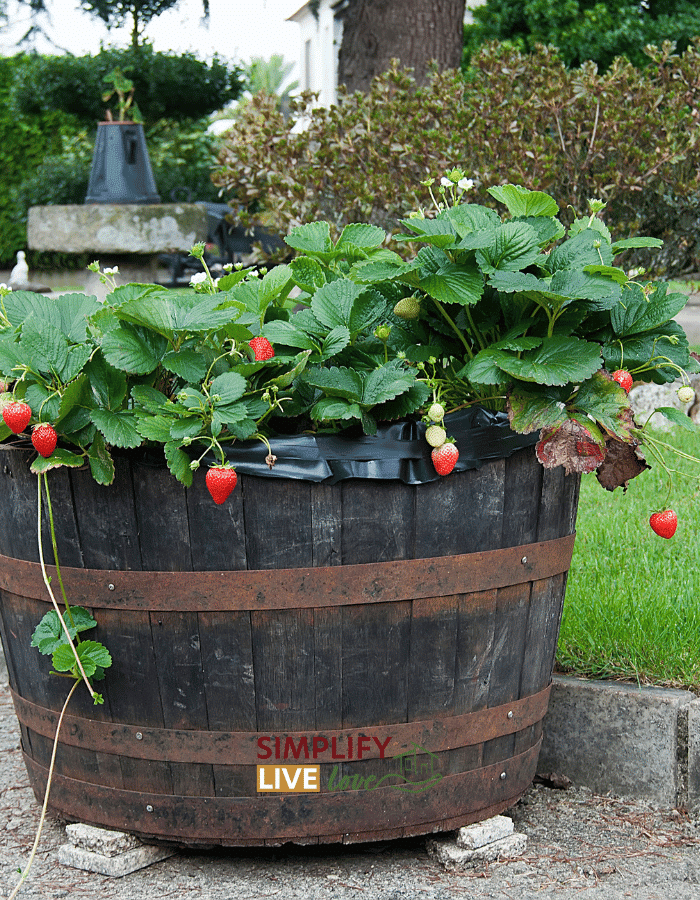
How to Grow Strawberries in Pots and Containers
You can grow strawberries in pots just like you would in the ground. The main thing to remember is their root system is more delicate in a pot.
That makes them more likely to dry out, so you’ll need to water them well in the morning to make it through the hot summer days.
When they quit producing, it’s time to replace them with new plants.
Strawberry Problems: Pests and Diseases
Everyone loves strawberries. From birds to slugs, you will find you aren’t the only creature looking forward to sweet, delicious strawberries.
Common Strawberry Pests
Strawberry pests like slugs, thrips, and weevils, often seek out weak plants. You can help keep the plants healthier by putting straw or other mulch in the beds, especially under and around the plants. The mulch prevents many fungal and rotting issues which attract pests.
Regularly spraying strawberries with a citrus-based soap will help prevent many pest issues. You can cover strawberries with a floating row cover or after planting to help them get a healthy start. You can reuse the row cover as bird netting once the berries ripen to protect them from birds and other hungry animals.
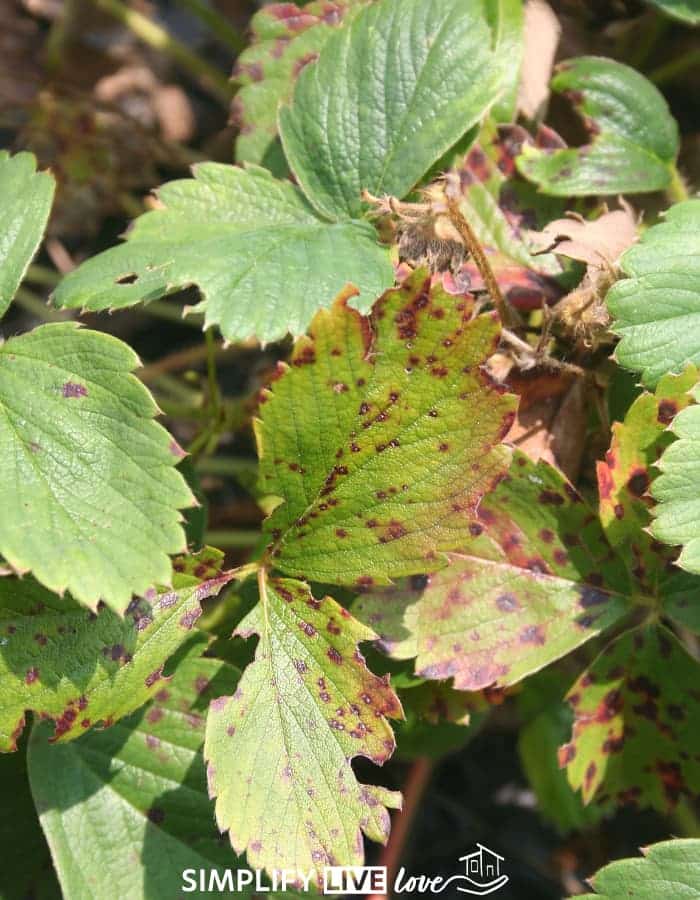
Common Strawberry Diseases
Strawberry plants are susceptible to several fungal diseases, including leaf spot, powdery mildew, and Botrytis rot. These diseases can cause significant damage to the plants and reduce fruit yield.
During wet weather in early spring, you see circular brown spots on the leaves indicating leaf spot. This can be controlled by removing infected leaves and applying fungicide like Neem Oil. However, leaf spot only needs treatment if you notice lots of dying leaves. Often, it’s just a cosmetic problem that doesn’t need treatment.
Powdery mildew causes a white powdery coating on the leaves and can also be treated with fungicides, baking soda, or a vinegar water mix.
Botrytis rot, also known as gray mold, causes fruit to rot and can be managed by using soaker hoses to water instead of overhead irrigation, removing infected fruit, and applying fungicide.
Be proactive about removing damage or rot as soon as you see it to help keep your strawberry patch healthy and producing.
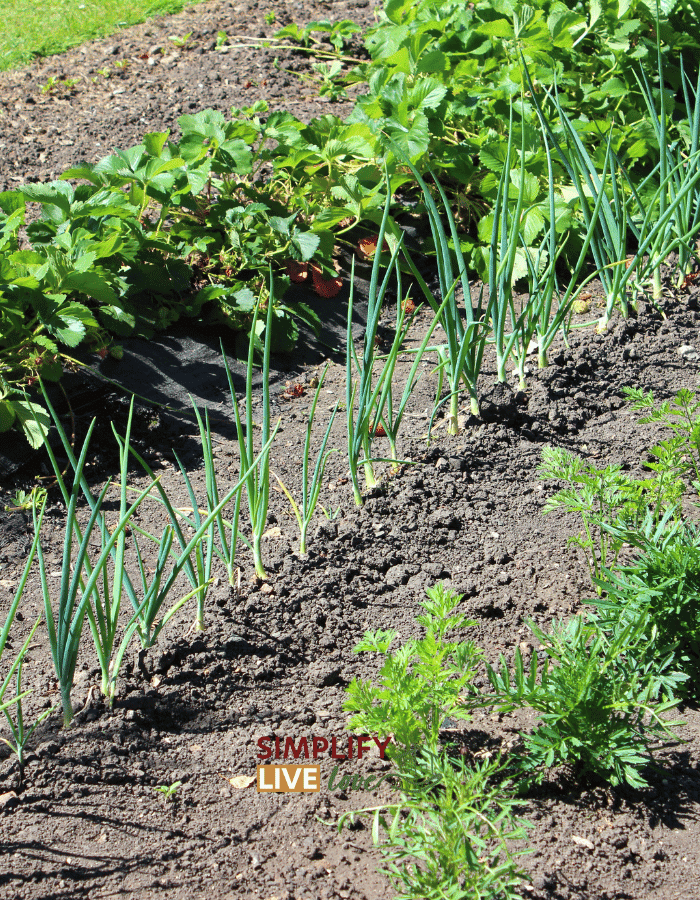
Best Companion Plants to Use & Which Ones to Avoid
I love to grow onions and garlic with my strawberries because bugs looking for strawberries are disgusted by the allium family. They grow well in asparagus beds, with peas, lettuce, other greens, and even rhubarb. No surprise there, though, as strawberry rhubarb pie is fantastic!
You will want to avoid planting strawberries with tomatoes, peppers, melons, potatoes, okra, mints, or roses, as they share many diseases and pests. It is also best not to plant a strawberry bed where any have been grown over the past three years to ensure the pests and diseases have died out.
How Long Do Strawberries Take To Grow
Strawberries take a year to grow a good harvest unless you raise everbearing strawberries. It takes 4 to 6 weeks from blossom to fruit. Warmer zones have fruit quicker than cooler zones.
When to Harvest Strawberries
To get a high yield and to encourage your strawberries to keep producing, you need to harvest berries at least every few days. I prefer to gather ripe strawberries daily as they will be full of sweet flavor. If you’re unsure, do a daily taste test to see the best time to harvest.
How to Harvest Strawberries
The best way to harvest strawberries is to cut the strawberry from the stem with a sharp knife or shears about ¾ inch from the fruit. Cutting prevents damage to the plant. Although it’s tempting, don’t pull the stem.
If you have little ones, teach them to hold the stem with one hand and gently pull the ripe fruit off the calyx. Harvesting this way will also prevent damage, and since little ones tend to sit and eat in the garden, you do not have to worry about storage rot.

How to Preserve Strawberries to Last all Year
What you need to remember about strawberries, is you won’t get much of a harvest the first year of planting. That first year, the plants need to focus on plant growth so they can grow delicious large strawberries for you the following spring. The next spring, you’ll need these tips for making the most of your harvest.
First, strawberries naturally carry mold spores, so it’s important to wash them before eating. Use 1 part vinegar to 3 parts water, dry them, and store them in the fridge. You can also wash them as you use them, but I prefer soaking them to ensure I get off all the bugs and keep them out of my fridge.
There are lots of ways to preserve strawberries to enjoy all year: freeze them whole or sliced for smoothies and pancakes, can them in various recipes or syrups, or dehydrate them.
Check out my favorite strawberry recipes:
How to can strawberry syrup – it’s the best!
My Great-great- grandma’s strawberry shortcake
Strawberry Rhubarb Crisp and Muffins
Need More Gardening Tips?
10 Most Effective Types of Organic Garden Pest Control Methods
5 Genius Tips to Make Garden and Plant Watering More Eco-Friendly
The Ultimate Guide to Finding and Using Free Mulch
7 Methods of Natural Weed Control for a Weed-Free Garden
How to Grow Garden Vegetables Series
Want to learn how to grow all the garden vegetables? Check out my How to Grow Series and learn to garden like a champ! More posts coming soon!
- How to Grow Broccoli from Planting to Harvest
- How to Grow Brussels Sprouts
- How to Grow Carrots from Planting to Harvest
- How to Grow Corn in Your Backyard Garden or Homestead
- 21 Tips for Growing Cucumbers in Raised Beds & Containers
- Beginner’s Guide to Growing Garlic
- How to Grow Lettuce Like a Champ
- How to Grow Big, Flavorful Onions from Planting to Harvest
- Growing Snap Peas, Shelling Peas, and Snow Peas
- Growing Potatoes the No-Dig Way
- What You Need to Know to Grow Yummy Big Strawberries
- How to Grow Rhubarb – Tips and Tricks for a Good Harvest
- 19 Secret Tomato Growing Tips
- How to Grow Zucchini in a Pot
